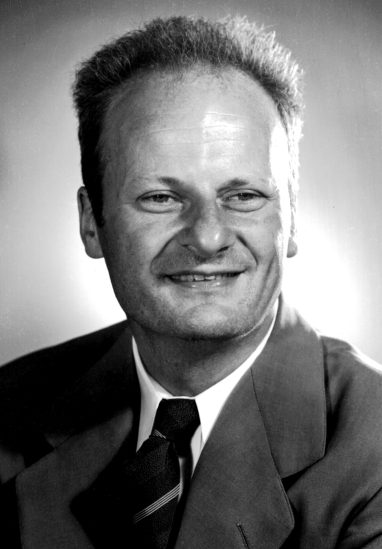Hans Bethe (1906-2005) was a German-American nuclear physicist and winner of the 1967 Nobel Prize in Physics.
After becoming an American citizen and gaining his security clearance, war work took him to the Radiation Laboratory at MIT, working on microwave radar. After spending the summer of 1942 at the University of California, Berkeley working on a design for the atomic bomb, Bethe was selected by J. Robert Oppenheimer to lead the T (Theoretical) Division of Los Alamos. He and his wife Rose moved to Los Alamos in 1943. Their son, Henry, was born at Los Alamos.
As theory chief, Bethe oversaw and coordinated the work of the various theory groups working on creating a model for how neutrons diffuse through a critical mass, figuring out how to calculate the efficiency of nuclear explosions, determining critical masses and the limits of sub-critical ones, understanding how liquids and gases behaved in fractions of micro-seconds at immense temperatures and pressures, and designing an initiator.
Bethe completed the theoretical work on the implosion method used in the Trinity test and “Fat Man” weapon dropped on Nagasaki, which validated his results. He also studied the hydrodynamic aspects of implosion, the neutron initiator, and radiation propagation from an exploding atomic bomb.
Scientific Contributions
Bethe was a professor at Cornell for his entire career, except for two sabbatical leaves and his absence during World War II when he worked on the Manhattan Project. At the end of World War II, Bethe worked on the United States’ development of the hydrogen bomb, although he was opposed to the weapon’s development and hoped that he would show that the H-bomb was impossible to build.
Between 1956 and 1964, he served on the President’s Science Advisory Committee, and in 1958 he headed a presidential study of nuclear disarmament. He helped to negotiate the 1963 Limited Test Ban Treaty with the Soviet Union, and acted as an informal advisor to Presidents Eisenhower, Kennedy, and Johnson. Later, he campaigned against President Ronald Reagan’s proposed Strategic Defense Initiative missile system and advocated for the peaceful use of nuclear energy.
In 1967, Bethe was awarded the Nobel Prize in Physics for his work on how stars produce energy. For more information on Bethe’s scientific research and achievements, visit the Nobel Prize website.





